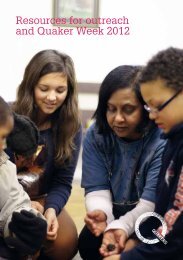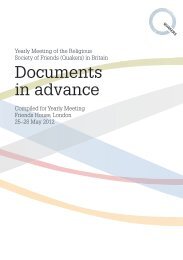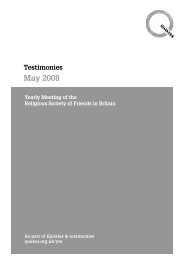Circles of Support and Accountability - Interim report [PDF ... - Quakers
Circles of Support and Accountability - Interim report [PDF ... - Quakers
Circles of Support and Accountability - Interim report [PDF ... - Quakers
Create successful ePaper yourself
Turn your PDF publications into a flip-book with our unique Google optimized e-Paper software.
Introduction<br />
It is not difficult to imagine some <strong>of</strong> the negative feelings <strong>of</strong> a man being released after years in<br />
prison, especially if he has been rejected by family <strong>and</strong> friends because <strong>of</strong> the nature <strong>of</strong> his crime.<br />
Bitterness, loneliness, fear <strong>of</strong> being recognised, alienation from society… And it is increasingly<br />
being acknowledged that a sex <strong>of</strong>fender who comes out <strong>of</strong> prison in that frame <strong>of</strong> mind is more<br />
likely to re-<strong>of</strong>fend, even if he starts <strong>of</strong>f with the best <strong>of</strong> intentions.<br />
<strong>Circles</strong> <strong>of</strong> <strong>Support</strong> <strong>and</strong> <strong>Accountability</strong> is a scheme which was first developed in Canada in the mid<br />
1990s to address that very situation, <strong>and</strong> <strong>Quakers</strong> <strong>and</strong> many others are working to get the same<br />
approach established in Britain. At its heart is a way <strong>of</strong> working which might be described as a<br />
partnership between voluntary <strong>and</strong> statutory agencies <strong>and</strong> the community. In Canada it grew out<br />
<strong>of</strong> the principles <strong>of</strong> restorative justice, which seeks to involve, <strong>and</strong> work for the benefit <strong>of</strong>, the<br />
victim, the <strong>of</strong>fender <strong>and</strong> the wider community.<br />
In the Canadian criminal justice system there was a paradox. Most prisoners were released from<br />
prison before the end <strong>of</strong> their sentence <strong>and</strong> for the remainder <strong>of</strong> the period were given some form<br />
<strong>of</strong> supervision in the community. But prisoners who were considered too dangerous to release<br />
before the end <strong>of</strong> their sentence were given no support or supervision after release. Ministers felt<br />
some moral obligation for these ‘warrant expired’ prisoners <strong>and</strong> this formed one <strong>of</strong> the catalysts<br />
for <strong>Circles</strong>. There was also a felt need to address the sense <strong>of</strong> powerlessness within the community<br />
when potentially dangerous prisoners were released. Groups <strong>of</strong> individuals, mainly churchgoers,<br />
responded by spontaneously forming small groups or circles around one or two particular<br />
<strong>of</strong>fenders <strong>and</strong> from these informal beginnings a project grew, partly funded by the Correctional<br />
Service <strong>of</strong> Canada (which runs their prisons <strong>and</strong> probation) <strong>and</strong> administered by the Mennonite<br />
church. The police in the parts <strong>of</strong> Canada where <strong>Circles</strong> have been operating for some time have<br />
become convinced that the scheme works <strong>and</strong> now co-operate with it.<br />
How the scheme works in Canada<br />
It seems sensible at this point to describe the ‘classic model’ <strong>of</strong> a Circle <strong>of</strong> <strong>Support</strong> <strong>and</strong><br />
<strong>Accountability</strong>, though there are many slight variations. The <strong>of</strong>fender is identified while still in<br />
prison – up to a year before release. He (<strong>and</strong> it was always ‘he’, at least in the early years) will be a<br />
high risk sex <strong>of</strong>fender, with high levels <strong>of</strong> need <strong>and</strong> little or no support from family or friends in<br />
the community. He is usually at ‘warrant expiry’. He is referred to as the ‘Core Member’ <strong>of</strong> the<br />
Circle. Many <strong>of</strong> the Core Members will have committed <strong>of</strong>fences against children, but those who<br />
have <strong>of</strong>fended against adults are also included in the scheme.<br />
The volunteers have to be prepared to make a substantial commitment <strong>of</strong> time, over a period <strong>of</strong><br />
one year in the first instance. They must be willing to befriend the Core Member, but don’t need to<br />
be experts. They need to be responsible people with their feet on the ground, mature about their<br />
own sexuality. Volunteers are screened, trained <strong>and</strong> supported by the <strong>Circles</strong> scheme. Typically,<br />
four to six volunteers will be allocated to a Circle. If possible, the Circle <strong>of</strong> <strong>Support</strong> <strong>and</strong><br />
<strong>Accountability</strong> will meet with the Core Member before he is released.<br />
3



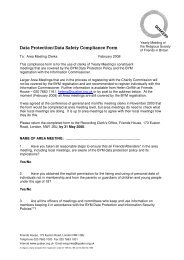


![2002 YM Minutes [PDF: 108k - opens in new window] - Quakers](https://img.yumpu.com/31588902/1/184x260/2002-ym-minutes-pdf-108k-opens-in-new-window-quakers.jpg?quality=85)
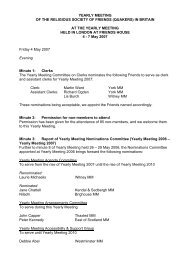

![Quaker Work in 2007 [PDF: 826kb - new window] - Quakers](https://img.yumpu.com/30178807/1/184x260/quaker-work-in-2007-pdf-826kb-new-window-quakers.jpg?quality=85)
![2004 YM Minutes [PDF: 132k - opens in new window] - Quakers](https://img.yumpu.com/29621403/1/184x260/2004-ym-minutes-pdf-132k-opens-in-new-window-quakers.jpg?quality=85)
